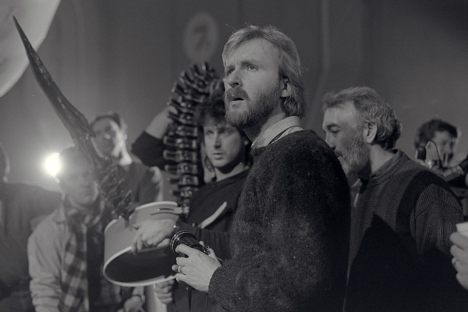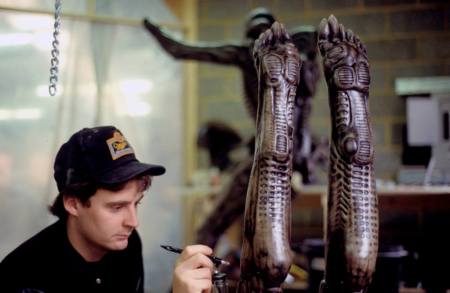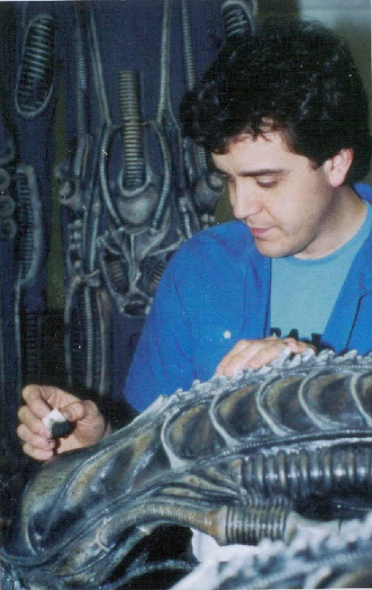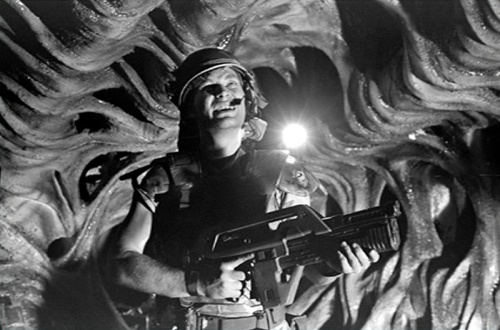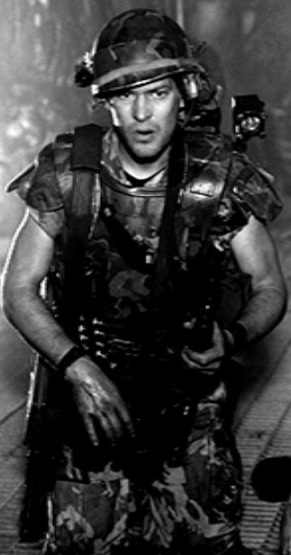
“Tight on several walls and ceiling niches as they come alive. Bone-like, tube-like shapes shift, becoming emerging Aliens. Dimly glimpsed, glints of slime. Silhouettes…”
~ Aliens script.
Recreating the star beast of Alien was arguably the sequel’s most deciding task. HR Giger’s original creature had reached near-mythic status among science-fiction and horror fans, but Aliens writer and director James Cameron wanted to do more than simply recreate the first eponymous Alien – he wanted to adapt Giger’s monster to the new, more grounded environment of Hadley’s Hope, reshape it for war whilst staying true to the original design, and make additions to the creature’s overall mythos without veering too wildly away from O’Bannon and Giger’s creation.
Copying Giger wholesale would have been straightforward, but Cameron felt that doing so would be a cop-out, and as an artist and designer himself, he wanted to have an influence on the Alien’s appearance. One immediate problem to tackle was the sheer number of creatures assaulting the screen.
Given that the budget would only allow the creation of several Alien suits (the original had been manufactured at the cost of more than $250,000) and considering that the original suit made several movements “impossible” (according to performer Bolaji Badejo), Cameron and Winston found that slavishly re-creating it was not a viable move to make. Instead, they used black unitards and pieced parts of the Alien form over the top of the material. As the emphasis was on merely suggesting the look and shape of the creature, rather than over-exposing it, the dark unitard would be hidden in shadow, with only the highlights of the Alien marauders visible in the strobing lights and muzzle flash.
The script for the first encounter between the Colonial Marines and the Aliens constantly refers to the creatures in physically ambiguous terms, describing them as “nightmarish figure[s]”, “dark shapes”, “silhouettes”, and the encounter itself as a “battle of phantoms” – though you saw more Aliens, you didn’t see more of them.
Xenomorph: Gorman refers to the unknown alien as a “Xenomorph”, a supposedly generic term in the USCM for an unidentified alien being. The term itself is a carry-over from an earlier Cameron project called Mother. “In Mother, humans have plundered Earth and look to exploit another planet,” explained Cameron. “In addition to mines on this planet, the Company sets up stations devoted to research and development. Because the planet’s environment is dangerous to humans, a ‘xenomorph,’ my term for a genetically engineered alien creature, is created based on a local life form in order to serve the needs of the Company.”
For Alien, Ridley Scott opted to show his creature in quick cuts or in the flash of a stroboscopic light for several reasons. Firstly, the suit was so unwieldy and cumbersome that it looked ridiculous when fully exposed. “It helped that the creature was so bad,” stated HR Giger, “because Ridley could only show it in glimpses.”
Nick Allder told Don Shay at Cinefex: “At one point the script called for it to run up and down the corridors like a human being; but when we finally got the finished costume … we found it would look ridiculous to see this thing running around – it would give the whole thing away immediately.”

The original Alien suit was meticulously crafted, but ultimately unwieldy and cumbersome. Many shots took an inordinate amount of time to set up and film, and most footage was thrown away. Cameron’s Alien suits on the other hand would be inhabited by dancers and gymnasts who needed maximum mobility. Here, we can also see Giger’s ribbed cranium and spike design, which was brought back to the surface for the sequel.

Stan Winston and his team crafted a series of 8 foot tall Alien puppets that could be set into inhuman poses and could also be rigged to explode when fired upon, spraying acid in all directions. The team also exposed Giger’s ridged cranium and smoothed over the eye sockets to retain the eyeless menace of the creature, though two barely legible indents mark the sockets.
Cameron’s Aliens would be required to run, leap, vault, crawl, climb, descend, and spring from the floor as well as the ceiling. Such movements were planned for Alien, but scrapped due to the suit’s logistics. During filming of the original, performer Bolaji Badejo bowed out of the Brett death scene due to discomfort: “I couldn’t do it,” he told Cinefantastique, “I was held up by a harness around my stomach, and I was suffocating trying to make these movements.”
Badejo also claimed that when crawling out of the bulkhead space inside the Narcissus, the Alien suit would split almost every time: “I must’ve ripped the suit two or three times coming out, and each time I’d climb down, the tail would rip off!”
Ridley had also planned sequences with the Alien roaring towards Dallas in the vents, “running and jumping full-circle around the walls” to snatch the Nostromo’s captain, but the logistics of the suit (in addition to being unable to build tunnel-like vent sets) curbed these ideas. “Ridley had a lot more ideas than what you see on the screen,” Badejo elaborated, “but some things were impossible.”
Considering the athletic abilities required for the new movie, the original suit’s fragility and cumbersome fit was not something that could be tolerated for the sequel. James Cameron: “I put the old [Alien] suit on myself, so that I could understand from standing outside what it was like to be inside … And I couldn’t see anything. I knew I would never get the kind of movements I wanted from the actors in that suit.”
He explained further: “I went more for motion as opposed to design. We kept the design more or less the same as [Alien] … We spent most of our R&D time on motion because I thought that quick blurring, lizard-like, or insect-like leap was more important than the physical, sculptural design of the suit. And I think that that’s a mistake that a lot of make-up and prosthetics people make when they’re dealing with this sort of thing is that they lavish all their attention on the sculptural detail –the surface texture, etc.– and they fail to realize that people need very few pixels of information to identify a human figure, and most of that identification is through motion. The way we walk is so ingrained in us mentally that you can see it just like that. So what we did was we actually re-designed the suit and made it simpler and less sophisticated and basically freed it so that it was much more flexible.”

“The silhouette of the Alien was the most important thing, and we were able to get that with these suits that were literally black leotards with pieces glued onto them. That gave the performers complete mobility, which allowed Jim to put them on wires and make them crawl up walls and flip the camera upside down so that it looked as if they were scurrying across the ceiling.”
~ Stan Winston, The Winston Effect, 2006.

“I think the biggest design changes when you went from Alien to Aliens was the fact that, technically, the suits were far simplified. That was in an effort to gain them maximum mobility. Cameron knew exactly how he was gonna shoot these things. He knew how it was going to be an interplay between shadow and light on these things. That was the whole element of the Aliens that he wanted to get across on film, seeing the movement of living creatures coming out of the dark and into the light, moving through the light and never really focusing, never studying them.”
~ Tom Woodruff, Making of Aliens, 2003.
One problem for the production was replicating the immense size of the Aliens. “For Alien,” explained Cameron, “they went out of their way to find a very tall person to be inside the suit – Bolaji Badejo was something like seven feet tall. We knew right off that we weren’t going to find ten people who were seven feet tall.”
Cameron’s concerns were allayed when he realised that Badejo only featured in certain scenes, with some of the first, infamous shots of the creature with Brett and Dallas being played by the smaller Eddie Powell. With careful editing and suggestion, Ridley Scott had fooled many viewers into thinking the Alien was consistently large.
“In studying Alien,” said Cameron, “we found that there was really only one shot in the entire film that shows a direct scale relationship between the creature and a human being. In all other shots, it exists separately in the frame.”
Cameron utilised Scott’s power of suggestion and editing, whilst eight-foot-tall puppets crafted by Stan Winston filled in for a larger performer (so technically speaking, the Aliens in the sequel are a full foot taller than Badejo. Or at least the puppets are.) Stunt performer Eddie Powell, who played the Alien as it kills Brett and snatches Dallas, also returned to don the suit.

Bolaji as the Alien, contrasted to Stan Winston’s 8 foot tall puppets
To aid them in the specifics of the Alien’s design, Twentieth Century Fox shipped the original suit to Winston’s crew. “Our shop used to be on Parthenia Street,” explained Winston employee Shane Mahan, “and Stan says, ‘Look, there’s a big crate coming from London, about the size of a coffin and when it comes in, we have got to take a look at what is inside.’ … Fox had sent us the original suit … we uncrated it and of course the horrible smell of decaying rubber and sweat and all of that came pouring out, but there at the bottom of this thing were all of the components to what Giger had built. It was ratty and a bit torn up, but it was like, ‘There it is! There’s the monster right there!’ It was astonishing … It was definitely an inspiration.”
When they looked at the suit they found it was littered with bottle caps, macaroni pieces, oysters, bones, as well as pieces of a Rolls-Royce, all embedded onto the suit and sprayed black. For their own suits, instead of tacking and sewing pieces onto the rubber, they opted to form the tubing and pipes as small cohesive wholes or plates that could simply be glued onto the spandex undersuits in easy-to-fit chunks.
Stan Winston: “Details that were obviously tacked onto the first one -little hoses and things- we worked at in a sculptural way so that the organic and inorganic elements blended together better.”
“We pulled this thing [the original Alien suit] out of a crate, and it was unbelievable to see how it had been constructed. It had black, hand-painted macaroni pieces glued all over it to give it texture, with black-painted bottle caps at the waist. And the feet were just black Converse tennis shoes, covered with a slip-latex skin! When we got this thing out, put it on a mannequin, and saw it in broad daylight, it was amazing to see what Ridley Scott had gotten away with just by using slime and careful lighting and the right camera angles.”
~ Howard Berger, The Winston Effect, 2006.
Though the body remained the same between the first two films, and the feet and hands received only minor adjustments, the most obvious change was to the Alien’s head. For the original film, HR Giger designed a ‘ribbed’ cranium with a skull placed at the forefront. This head was covered up with the famous dome, hiding the design underneath (though it can be spotted in some behind-the-scenes shots.) Initially, the Aliens of the sequel were to also have domed heads, but when Cameron considered the logistics he ordered that they were removed in favour of the ribbed head underneath.
Winston employee Alec Gillis explained: “We built [the suits] so that they were more durable; they could go on and off quickly and that they wouldn’t have pieces that might be more susceptible to breaking. For instance, the dome on the Alien, Jim [Cameron] just wanted to remove it, he thought it would be a hassle, was afraid of it cracking or it having to be replaced – we’d have to cut [filming] and switch the dome [if it broke mid-shot.]”
Winston Studios employee Shane Mahan elaborated further: “We built it [a domed Alien head] and it looked beautiful. We built it in England and we put it all together and thought it looked great and then Jim said, ‘Take the dome off. Those are going to come off and fall or maybe break during all of the stunts.’ We were like, ‘No, you can’t!’ He had us remove it and that became its own look there for a long time, sort of a more streamlined thing, but it was originally meant to have that piece on it. I think someplace we have photos of it. We all loved the first movie. We wanted to… almost to a fault… where we were trying to replicate it so much and Jim would say, ‘No, let’s make it our own thing! It’s got to be kind of its own creature,’ and we finally got the concept and what he was trying to do.”
Aside from being more feasible from a technical standpoint, Cameron also liked the design of the ridged head, feeling it was a worthy enough feature to adopt as part of the Alien’s physical aesthetic. “We planned to [have a domed head] with ours,” he explained in The Winston Effect, “and to that end Stan Winston had Tom Woodruff sculpt up a ribbed, bone-like understructure that would fit underneath and be slightly visible through the cowl. When it was finished, they gave it a real nice paint job, and then I took a look at it and I said, ‘Hey, this looks much more interesting the way it is.’ So we ditched the cowl and decided that this was just another generation of Aliens – slightly mutated.'”
To stay faithful to the eyeless menace of Kane’s Son, Cameron smoothed over the front carapace of the Alien’s head, excising the skull and leaving the creature faceless and unknowable (Cameron’s explanation of the fear-provoking nature of the Alien was that it was predominately all teeth – the last thing you see before being devoured by a predator.)
Though the design was essentially his own, HR Giger missed the domed head from the original movie when watching Aliens, as much as he liked the sequel, commenting: “Aliens was also terrific. I am sorry I was not asked to work on it. At first I thought, ‘This is like a war film,’ but it is really powerful. But I didn’t like the ribbed cranium of the Alien warrior, although you couldn’t see the Aliens very much. However I loved the Alien Queen designed by James Cameron.”

Alien heads.

The lycra/spandex suits with pieces glued on top.
Cameron called Aliens a war film, and in war films there are casualties on both sides, and sometimes you have to be Machiavellian or even self-destructive in order to win or preserve your society as a whole, and the Aliens in the sequel do precisely that. The Alien in the first film was likened to, by Dan O’Bannon an inexperienced and curious child, albeit an extraterrestrial one: “It’s never been subject to its own culture, it’s never been subject to anything except a few hours in the hold of the ship.” Ridley described it as a self-propagating machine, a “biomechanical insect.”
The Aliens of the second film were likened to the Viet Cong or guerrilla fighters in that they are a hidden, nigh-on irrepressible, non-technological and not-at-all battle shy force. They’ve been to war before with the colonists. They’re essentially an army. They manage to mobilise themselves before demoralising and decimating their enemy. James Cameron told Starlog magazine: “The Aliens are terrifying in their overwhelming force of numbers. The dramatic situations emerging from characters under stress can work just as well in an Alamo or Zulu Dawn as they can in a Friday the 13th, with its antagonist.”
When the Marines wander inside the Alien nest, they find … nothing. At first. The biomechanic appearance of the Aliens allows them to meld perfectly within the walls of the Hive. They slide out of their holes and the walls begin to treacle down towards the troopers on the ground…

ANGLE ON WALL as something begins to emerge. Dimly glimpsed, a glistening bio-mechanoid creature larger then a man. Lying dormant, it had blended perfectly with the convoluted surface of fused bone. The troopers don’t see it. Smoke from the burning cocoons quickly fills the confined space. Visibility drops to zero…
